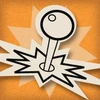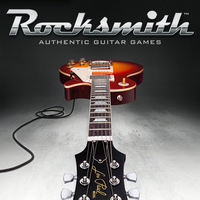
Rocksmith
61 Achievements
191-233h

Scales Owned
Beat 50,000,000 points in the Guitarcade game: Scale Runner
0.9%
How to unlock the Scales Owned achievement in Rocksmith - Definitive Guide
I have several pointers for those who are having trouble with this beast. First off, the first several notes will be a full scale run for whichever scale you want to play. In the "Select A Scale" menu, you will find a scale pattern on the bottom left corner of your screen. That is what you're gonna start off playing. It will ascend from the bottom (thick) strings all the way to the top (thin) strings and will descend from top to bottom. i.e., if you choose to play the A Major scale, it was ALWAYS start with the following scale:
A b c# D E f# g# A b A g# f# E D c# b A
I only mention this so that you can quickly blow through these first several notes to help get your speed bonus going. After the descend is over, it's all random.
Well, I take that back...when you hit a note, the next note will only be a neighboring note. In the A Major example, the A will always lead up to a b or g#, the b leading to a c# or A, and so on and so forth. Keep this in mind so that you can limit your options when running a scale.
When you select your scale, you will have your options of keys to play in. Since playing in different keys won't add to your score pool, I recommend sticking to the A major scale. Not all guitars are created equal and some guitars have terrible intonation. Guitarists will tell you the higher up the neck, the worst the intonation can get. This is especially true with the thick strings at high fret levels. The 5-8 fret range will allow for a viable medium of intonation and fret spacing. Since the game depends on the tone/tuning to register what you're playing, it's kinda important to keep that in mind. If your guitar has bad intonation that the 5-8 fret range throws the game off, you can switch the key to F#/Gb...or get another guitar. If you have a guitar with incredible intonation and want smaller frets to play with, go higher but ONLY if the guitar has good intonation.
When the scales start coming down at a quick pace, I don't really pay attention to what note I need to play next, as I'm more focused on the scale pattern itself. My eyes are focused at the END of the tunnel, instead of what's being brought to the front of the screen. I reason this because this is all just a game of patterns. If I can anticipate what's coming in the back end, then I can prepare of it. I don't know if that makes any sense, but if gets too crazy when the speed is getting too much, put your focus in the area of the screen where the numbers start to appear. It worked wonders for me, except for the Minor Pentatonic pattern. It's difficult as sin to read the bottom 4 strings at a fast pace.
Hope this helps. Any questions? Ask away. I'll see if I can help!
note detection is a bit glitchy. as per my comment above, there are times you're picking the notes way ahead - and you can hear them picked off through your speakers - but the game doesn't recognize them. this can become frustrating, but just keep at it and you'll eventually get a good score.
i played this after the august 2012 update, and it seems that once you start your run on the first scale, you should make a run on the remaining 10 scales to unlock the achievement. your scores will be saved on the leaderboards (both offline and online), but even if you just exit from the mini-game and go back to the main menu/journey screen, your scores will reset to zero and whatever points you got off towards building to the 50 million mark will be gone and you have to work your way back again.
finally, this is the best mini-game of the lot, since it really helps you develop muscle memory and finger strenght and dexterity; as well as teach you the different scales that you can incorporate to your own style of guitar playing. even if you have already unlocked this achievement, if you plan on playing more rocksmith and more guitar in the future, this mini-game is a very useful tool to improve your playing.
-Try to keep your hand in one position.
-The notes you have to play are always neighboring to each other; You don't have to worry about string skipping.
-It is always better to play slow and accurate, than to play fast and sloppy.
-The more notes you play in a row, the more score you get from them. This is vital to getting a really good score.
-You can play the notes as fast as they show up on the screen.
-...Try not to blink.
This is probably the best game to help improve your guitar playing skills. This helps you practice 11 different scales. This does not require you to score 50 million points on a single scale. This is the combined score of all 11 scales which requires an average of 4.6 million points for each one.
Once you select a scale, you can choose the key you want to play it at. This will determine which frets you will play it at and all notes will be within a 4-6 fret range. As you play the scale correctly, the speed will increase as well as the amount of points scored until you reach the highest speed level, 40. Using the "Pause Cheat," is tricky during this as you can fail to pause before the next note in the scale.
This is like Super Ducks, but only within a 4-5 fret range. It's also a scale (so the notes go up and down in sequence, rather than jumping around everywhere). 50,000,000 seems high, but your high score is a total of your high scores from all 11 scales. You'll only need a little over 4,500,000 million on average per scale to get this, making it significantly easier.
Tips for passing the test:
- start practicing with simple scales. In simple scales there is a small spread of frets and a minimum number of notes on one string (in the simplest scale there are two frets on one string, it is the third on the list). Train one scale until you reach the minimum required number of points (at least 3-4 million to start with), only then move on to the next one.
- the first few notes will always be the same and they will always go along the strings from top to bottom and bottom to top (full run of the scale), then in random order. This means that you can get used to the first block and accelerate on it.
- when you play a note, the next one will always be adjacent in the scale, remember this, it simplifies the game, you don’t need to think about skipping strings
- always keep your hand in the same position
- if you don’t have time, it’s better to slow down the tempo and play more accurately than to hit anything. Especially in light of the fact that points, like everywhere else, grow exponentially with long series. In general, the most important thing for this exercise is to maintain the rhythm of the game.
- After selecting the type of scale, the game provides a choice of key. The tones themselves do not affect anything other than the physical location of the game. I recommend always playing in the same key. It's easier to learn. Choose a place on the fretboard where it will be easier for you to play: at the beginning of the fretboard, the frets are wide, the string tension is greater and it will be harder to press them. At high frets, the frets are narrow and it is easier to press down on the strings, but your guitar may have strings further away from the fretboard. Also, at high frets, the guitar can introduce a significant error of its own in determining the note by playing. I prefer to play the scale starting from the 10th-11th fret.
- notes should be read where they appear in the distance, and not where they should already be played.



 Devil May Asian
Devil May Asian
 TrueAchievements
TrueAchievements
 Carlos Again
Carlos Again
 Wozamil, Bezenko, DLC
Wozamil, Bezenko, DLC
 stratege.ru
stratege.ru
 PSNProfiles
PSNProfiles